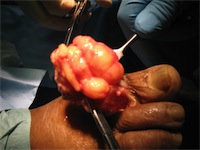Ganglions, Lumps and Bumps
Feet can develop ‘lumps and bumps’ for a variety of reasons.
What is a Ganglion?

Irritation, overuse or injury to tendons can create a bulging of the tendon sheath. This fills with synovial fluid from the tendon lining and develops to resemble a soft balloon deep under the skin and fat layer. It is usually mobile but anchored to the tendon. Ganglion are known to reduce or increase in size.
Similarly, joints are also lined with a synovial capsule. The capsule can be damaged by injury, or mechanical stress in badly aligned feet. This capsular damage area enlarges to form the ganglion. It is usually filled with synovial fluid from the joint.
What can be done to treat it?
Ultrasound or IMR imaging is usually performed to confirm that the ‘lump’ is a ganglion. The imaging may reveal that the structure is larger than can be seem in a clinical examination.
Some ganglion can be drained by a needle under local anaesthetic. This is a relatively pain free and quick procedure. The ganglions sometimes recur after drainage.
Surgical excision. An incision is made in the skin, over the ganglion so the entire structure is removed. Recovery is relatively quick. Dissolvable stitches are used where possible.
Lipoma, Fibroma, Neuroma
Other Lumps on the foot can be painful in shoes, or because they are located in an area where they are compressed. Common foot ‘Lumps and Bumps’ include, fibroma, Lipoma, neuroma. They can be similarly excised under local anaesthetic.
All tissues are sent to pathology after their surgical removal in order that the ‘lump’ can be identified and given a definitive diagnosis.
